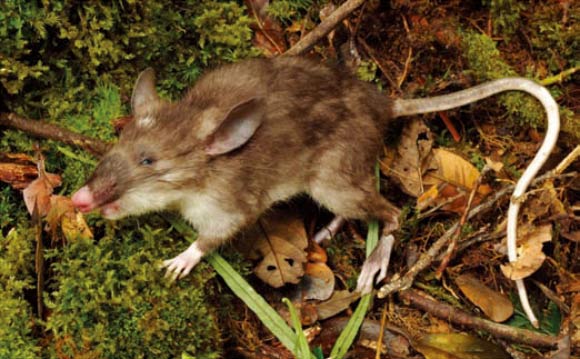Dr Jake Esselstyn of Louisiana State University and his colleagues from Indonesia and Australia have discovered a new genus and species of shrew rat in the north peninsula of Sulawesi Island. Research describing the new animal is published online in the Journal of Mammalogy.

The Sulawesi snouter (Hyorhinomys stuempkei). Image credit: Kevin C. Rowe / Museum Victoria, Melbourne.
The discovery of this new genus and species, Hyorhinomys stuempkei, brings known shrew rat diversity on Sulawesi to 6 genera and 8 species.
“The new genus is named for its hog-like nose, by combining the Greek ‘hyo’ (hog), ‘rhino’ (nose), and ‘mys’ (mouse),” Dr Esselstyn and co-authors wrote in the study.
“The species is named in honor of Gerolf Steiner, who used the pseudonym Harald Stümpke, to publish a small book (Bau und Leben der Rhinogradentia) commonly known in English as The Snouters.”
“The Snouters describes a fictional island radiation of mammals with extraordinary nasal and aural adaptations and seemingly anticipates the discovery of Hyorhinomys stuempkei, with its large pink nose and long pinnae.”
“We recommend ‘Sulawesi snouter’ as an English common name,” the scientists wrote in the paper.

The Sulawesi snouter (Hyorhinomys stuempkei). Image credit: Jake Esselstyn / Louisiana State University.
“We had never seen anything like this,” Dr Esselstyn said.
Hyorhinomys stuempkei has a large, flat, pink nose and forward-facing nostrils.
It has a small mouth (relative to head size), large ears measuring 21 percent of head and body length, long hind legs that may be used for hopping, very long urogenital hairs and long white incisors.
Long incisors are a trait of shrew rats, but the Hyorhinomys stuempkei has especially long incisors.
“The fur is strongly bicolored with a blotchy brown-grey dorsum and white venter,” Dr Esselstyn and co-authors wrote.
“The tail is slightly longer than head and body length and bilaterally colored on two axes, with a white venter and white distal end representing 60 percent tail length.”
“The tongue has a prominent longitudinal groove along its dorsal surface.”
Another distinct characteristic of the shrew rat is that it lacks a jaw muscle attachment point found in most mammals called the coronoid process on the dentary bone.
“I don’t know of any other rodents that have lost the coronoid process completely,” Dr Esselstyn said.
“The loss of the coronoid process indicates a weak jaw musculature and a diet that does not require vigorous chewing.”
Hyorhinomys stuempkei eats earthworms and beetle larvae, according to the scientists.
It is known only from the type locality at 1,600 m elevation on Mt. Dako, located on Sulawesi’s north peninsula.
“However, no montane sites on the north peninsula have been well surveyed for murines, and the breadth of this species’ geographic distribution remains an open question,” Dr Esselstyn and co-authors said.
_____
Jacob A. Esselstyn et al. 2015. A hog-nosed shrew rat (Rodentia: Muridae) from Sulawesi Island, Indonesia. Journal of Mammalogy 96 (5): 895-907; doi: 10.1093/jmammal/gyv093







